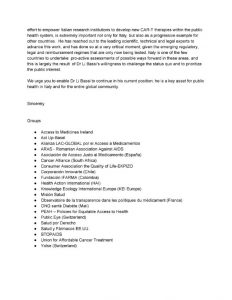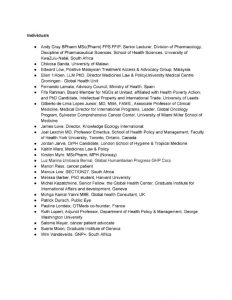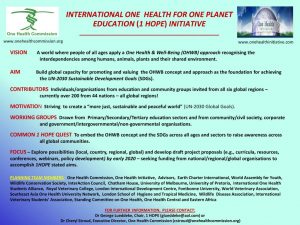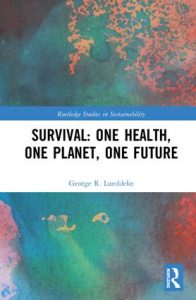Letter of support for AIFA (Italian Medicines Agency) Director General Dr Luca Li Bassi sent to Roberto Speranza, Italy's Minister of Health - 7 November 2019. The letter was signed by 21 organizations and 24 individuals
Author: Daniele Dionisio
Financialization of Health and the Impact on Peoples’ Lives
Overexpansion of the finance industry remains one of the systemic drivers of rising inequalities, in the face of the international community’s engagement to reduce them through the 2030 Agenda. This article maintains that, while the right to health is constantly redesigned to play an ancillary role to financial markets, the global health community needs to raise its visual spectrum beyond diseases to better understand and address the speculative dynamics of finance advancing in the health sector, with little promise of sustainability. Actually, the financialization of global health is in the crosshairs at a time when complex questions arise around governance, democratic, cultural and market related relevant issues
By Nicoletta Dentico
Executive Director, Health Innovation in Practice (HIP), Geneva
Steering Committe Member, Geneva Global Health HUB
Financialization of Health and the Impact on Peoples’ Lives
We live in a globalized economic system that is bound to reproduce a vicious cycle of inequalities. Rising inequalities between the global North and the global South, the economically privileged and the marginalized, among different genders and minority identities, have been historically reproduced and structured across generations, so much so that these are today the defining feature of our time. It is an undeniable fact that global challenges such as climate change and environmental degradation affect us all as humans living on this planet. Yet, they do not affect us all equally. Indeed, the impact of global warming is mostly felt by those who have least contributed to it, by those who are most marginalized from public service delivery, most exposed to economic instability and environmental crises. Growing economic disparity and wealth concentration kindle political inequality in all parts of the world, by expanding the capacity of corporate and financial élites to influence policy-making at national and international level, and therefore protect their wealth and dominant positions, or outright privileges. There is indeed an urgent need for people’s movements to converge around a common agenda for taking back our economies, reclaiming public services and protect natural resources.
The efficient allocation of capital is one of the most valuable tasks in a global economy, and it is impressive to realize that while three decades ago the average holding period of a stock was four years, today it is only 22 seconds. This is to say that finance has a tremendous potential. But we can do much better. The 2008 global financial crisis is a stark reminder that laissez-faire did not work. Financial markets left to themselves produced too-big-to-fail banks and did not trigger competition but rather oligopolies and vacancy of regulators. The prices of financial assets did not manage to signal the incoming crisis. The very high payments that come with profitable speculations which disrupt the economic system in countries and lead to collapse and misery for the million people affected – “financial weapons of mass distraction”, as investor Warren Buffet calls them – describe the route the world takes when “financial markets, financial institutions and financial élites gain greater influence over economic policy and economic outcomes”. This is what the financialization of the economy is about. A process that ultimately threatens the very funding efforts needed to meet the Sustainable Development Goals (SDGs), and makes us all vulnerable to the frequent crisis cycles that the casino capitalism driven by digital high-frequency trading needs to survive.
Addressing this phenomenon is the focus of the report Spotlight on financial justice: Understanding global inequalities to overcome financial injustice, launched at the end of September during the UN General Assembly in New York (http://citizensforfinancialjustice.org/resource/spotlight-on-financial-justice-understanding-global-inequalities-to-overcome-financial-injustice/). Through five thematic areas – 1. food and land; 2. health; 3. women’s rights; 4. housing; 5. infrastructure – the report illustrates how the overexpansion of the finance industry remains one of the systemic drivers of rising inequalities, in the face of the international community’s engagement to reduce them through the 2030 Agenda.
After the 2008 financial crisis started in the global North, the governance structures and the deregulation regimes that had got us there, especially the uncontrolled expansion of the financial sector over the real economy, finally raised enough red flags. Notwithstanding their direct responsibility in the global financial collapse, major banks were bailed out by governments using taxpayers’ money. At the same time, those very governments were overruling their human rights obligations by resorting to austerity measures to balance the loss of public finance, thereby creating pervasive negative effects on peoples’ lives, and dignity, around the globe. Consequences included reducing communities’ access to natural resources, restrictions on housing and employment, a considerable decrease of access to basic public healthcare services.
Greek people know only too well what financialization of health means, through the harsh lessons of EU austerity cuts and loan agreements imposed by the trojka (the European Commission, the European Central Bank and the IMF) to the Greek government, without any consideration for their potential side effects. The Greek administration, as the report accounts, was forced to reduce investments and put severe strains on core social services, which severely undermined community resilience to the crisis. The national health budget suffered a contraction of 36% between 2009 and 2014, which resulted in the meltdown of the Greek public health system. Infant mortality rose by 50%, especially among infant younger than one year. Chronic disease increased by 24,2%, due to the collapse of the healthcare system and the absence of the needed medical treatments caused by lack of financial means. Mental illness among the population soared from 3.3% in 2008 to 12.3% in 2013. Greece’s prescription for the shock to the healthcare system was state subsidized health insurance, but with the unemployment rate at 27%, many remained outside the eligible criteria. Cost sharing for healthcare increased remarkably even for those with insurance, while entitlement restrictions were introduced for childbirth and a range of other essential interventions.
The discourse on Universal Health Coverage (UHC) is today one of the driving institutional paths stimulating the penetration of private finance into the social arena of health, at country level. With different shapes, UHC is overall featured by concerted efforts to promote models of healthcare financing based on affordable user fees and voluntary health insurance schemes, alongside the expansion of privately owned healthcare infrastructures. In this way, loan based approaches like microfinance are opening up new opportunities for rent seeking from the poor. There has never been a more exciting time to be an investor in health, especially now that the combined burden of communicable and non communicable diseases is sharpening perceptions on the needs for health in lower income countries.
Beyond the health domain, the euphoria for financialization seems to have captured contemporary international development circles, primarily by means of multi-stakeholder partnerships. Escorting private finance into development is increasingly touted by alliances of multilateral institutions, national governments and owners of equity investment funds and private capital overall. The assumption is that multi-stakeholderism may be the solution to the current problems with the multilateral system[i], and that resorting to private money is the inevitable strategy if the world is to catch up for the estimated annual gap of US$ 2.5 trillion required to achieve the Sustainable Development Goals (SDGs) – a gap considered beyond the capability of public funding [ii]. The acceptance of an argument that makes poverty bankable finds in this context no institutional resistance. This is what drives new asset classes such as the impact bonds (like the Cameroon Cataract Performance Bond) or the catastrophe insurance schemes like the Ebola bonds, betting on international health outbreaks within the Pandemic Emergency Financial Facility.
The financialization of global health poses a range of complex questions:
- a governance issue, due to the fragmentation produced in the health system and the hybridization of the role of health institutions at all levels;
- a democratic issue, since financial markets are based on private agreements usually covered by a confidentiality clause. The use of public funding can be traced, at least in theory, while the same does not apply to private sector investments, which entails some negative externalities in terms of transparency and accountability;
- a market related issue, to the extent that the provision of healthcare services may end up being exposed to the volatility of the financial casino;
- a cultural issue, in the sense that health financialization may well influence consumerism, and people’s culture around the healthcare approach to be desired.
While the right to health is constantly redesigned to play an ancillary role to financial markets, the global health community needs to raise its visual spectrum beyond diseases to better understand and address the speculative dynamics of finance advancing in the health sector, with little promise of sustainability. This is urgent.
———————————————————–
[i] Gleckman, H. (2019), “How the United Nations is quietly being turned into a public-private partnership: A new agreement with the World Economic Forum gives multinational corporations influence over matters of global governance”, OpenDemocracy, 2 July 2019, https://www.opendemocracy.net/en/oureconomy/how-united-nations-quietly-being-turned-public-private-partnership/.
[ii] Hunter, B. and Murray, S. (2019): Deconstructing the Financialization of Healthcare, Development and Change 0(0): 1–25. DOI: 10.1111/dech.12517, p. 1
PEAH News Flash 355
News Flash Links, as part of the research project PEAH (Policies for Equitable Access to Health), aim to focus on the latest challenges by trade and governments rules to equitable access to health in resource-limited settings
News Flash 355
INTERVIEW – ‘Survival: One Health, One Planet, One Future’ – Routledge, 1st edition, 2019
The planetary health summit is born?
European Medicines Agency pledges to make clinical trial reporting easier for universities
‘Italy’s Way Forward in Clinical Trials Transparency’ by Luca Li Bassi AIFA’s Director General
DR-TB Drugs Under the Microscope, 6th Edition
Protestors demand Cepheid halve the price of GeneXpert TB tests to US$5
Price announced for new lifesaving TB drug pretomanid still too high
Deal slashes preventive TB medicine price by nearly 70%
TDR Bulletin on TB Research 30 October 2019
New blood test to detect Zika approved in Brazil
Advancing Health-Related SDGs In Africa Through Private Sector Collaborations
1 in 5 Rohingya Child Refugees Suffer Severe Mental Health Issues
Mental health in all policies in contexts of war and conflict
Real-Time Digital Surveillance of Vaping-Induced Pulmonary Disease
Pathology of Vaping-Associated Lung Injury
Proclamation On Health Insurance Requirements: The Administration’s Latest Attack On Immigration
High ambitions for health equity in the Americas
Abortion in Brazil: the case for women’s rights, lives, and choices
From Climate To AMR: World Health Summit 2019 Tackles Broad Agenda
With an Eye on Children, the IKEA Foundation is Stepping up its Work on Climate Change
Health Experts Push To Centre Health In Climate Action At World Health Summit
Going with the Wind: Transition to Clean Energy in Latin America & the Caribbean
Farmer to sue German government over failure to tackle climate change
New WHO report to bolster efforts to tackle leading causes of urban deaths
Philippines’ multisector approach to break the cycle of stunting
Reaching out and Engaging with SE Asian Communities: Health, Shared Value and Business
How can local businesses wilfully help alleviate some of the everyday problems faced by individuals and families in SE Asian communities? What roles can local companies play and what strategies can they deploy to help promote their products and services, whilst also acknowledging and addressing the pressures that people face every day? This article tries answering these questions by a shared value approach whereby social pressures and problems are identified as the raw material from which to build a sustainable competitive advantage
By Philip J Gover* BA MA MPH
Public Health Consultant
Cooperation Works
Reaching out and Engaging with SE Asian Communities
Health, Shared Value and Business in the Community
How can local businesses wilfully help alleviate some of the everyday problems faced by individuals and families in SE Asian communities? In an ever-increasing competitive environment, companies inform me that they are consistently looking for credible ways in which to connect with consumers, that allows them to both build mutually beneficial relations, whilst also delivering social outcomes.
Along these lines, what roles can a local company play and what strategies can they deploy to help promote their products and services, whilst also acknowledging and addressing the pressures that people face every day?
During a recent assignment with a local SME (Bottled Spring Water Company), I helped develop some ideas which were considered valuable in light of the aforementioned aspirations. I have provided some brief notes from this social development assignment which may offer ideas for other companies both locally and further afar.
Business in the Community
- Shared Value
In parallel with everyday operational and performance management activities, most companies are typically drawn towards ideas and options that help them to develop the market for their products and services. In view of this, companies often relaunch products and services, if only to refresh the important association that exists between them and their customer base. A number of regular and orthodox marketing tools and methods can be used to achieve this.
However, distinct from these typical methods and activities, it was noted that a different type of product relaunch could provide the company with an opportunity to do something socially different. Here, the product relaunch was intended to be used to inform the development of a more dynamic and engaging set of activities, that carry with it the prospect of delivering both customer loyalty and more sustainable socio-economic benefits, over the short, medium and long term.
In this approach, our proposed relaunch sought to consider the product(s) (bottled spring water), alongside the needs of the company, its customers, and the customers’ community environment.
At first, this might seem like a strange tactic to take. However, this approach enabled the company to engage in, and fully experience the lifeworld in which the customer and the customers’ needs exist. By fully engaging in these dimensions, the company wanted to both prepare and prime itself to exploit a richer depth of benefit.
Whilst this approach doesn’t seek to place every pressure and local problem at the door of every local company, it does offer a method by which companies can select and target pressures, based upon a considered assessment and prioritisation process. However, by collaborating with other businesses, using a similar methodology, this approach can become considerably more influential and powerful. A simple example can be given.
A mature company embraces this approach and considers the needs of the company, its customers, and the rural communities in which its customers live. The company chooses to print tokens on its product labelling, which guides and encourages customers to collect, on behalf of their children’s local schools. Upon redemption, participating schools are rewarded with books, microscopes or computers etc.
These types of incentives are important to both the company, customers and the community in which the customers exist. In the lifeworld of the customer, parents observe their children benefitting from enriched learning. The school benefits from closer ties with children’s families and increases its capability to teach and perform. Science is taught more robustly, and new learning quickly finds its way to discussions around the family dining table. A chain reaction of positive changes no less.
This type of business engagement also helps to reduce the educational inequality and disadvantage that besets customer communities. Changes in these areas bring increased hope and ambition to the lives of its population. Of additional importance, this range of benefits, which can be clearly measured and witnessed, becomes branded and attributed to the leadership of the company.
At present, many beverage companies in the community use customer reward programmes that involve ‘cash pay-outs’, or material ‘give-aways’ to ‘lucky’ customers. These simple gimmicks do little to reduce the preventable pressure on schools and communities, whose pupils will, at some future stage, represent the pool of local available talent. A talent pool that the company itself will depend upon, one day, for its future workforce. In this sense, the company engineers and reaps long-term benefits from an incentive scheme that promotes its product within the local educational base. By blending commercial interests with both customer and community interests, new and authentic customer relationships can be built.
- For the company, the value lies in the prospect of continuous increased brand awareness and customer loyalty.
- For the customer, value lies in the sense and feeling of improved cohesion within the family and community.
Fundamentally, this form of commercial cooperation builds and fortifies communities. If managed efficiently, this approach can provide the basis for a range of new commercial opportunities that stimulate growth.
In its simplest form, this overarching approach can be considered a mild form of ‘shared value’ and represents a management strategy that is being adopted today, by the most innovative companies throughout the world.
When shared value is adopted, the company becomes a valuable and enabling agent, both in the eyes of the customer and the community. When local businesses come together to pursue this collectively, in a coordinated manner, a circular and more sustainable economy evolves, that is capable of addressing social and economic pressures in transformational ways. This is nothing short of business leadership at its best.
In view of the market that is associated with bottled water, this type of activity could be of clear interest to a local Spring Water Company and represent an opportunity for discussion and decisive consideration.
- Opportunities for a Local Spring Water Company
Our company produces a valuable and familiar product, bottled mineral water. In a mixed marketplace. It competes in a space with a range of hot, cold, sugared, fruit-flavoured, caffeinated and alcoholic products, to name but a few. Yet, its unique selling point is valued and competitive. It is produced locally, at source, at a famous and historic site in SE Asia. It is mineral rich and healthy.
In view of this, and by adopting shared value, the Spring Water Company could lead, establish and benefit from advantages that help distinguish itself, from both rival and choice-based competing products.
As a starting point, it was suggested that the Spring Water Company consider the method and activities outlined above, and as appropriate, utilise the available training and development options, that exist, to assist companies in this area.
The shared value approach, and the distinct activities associated with it, is often prepared in advance of a focussed corporate event. A conference style relaunch event can often be used as a pinnacle event, to signal and announce both a new corporate motivation and desire to lead on new customer and community engagement methods. These events typically focus on, and reiterate a wilful emphasis around key themes:
- The company’s future depends on the authenticity of its customer engagement.
- Woven within the term sustainable development, is interdependence.
- Societal issues exist, which the company wants to influence, shape and change.
- That cooperation is a great equaliser.
- The future can be managed efficiently, using collaborative based partnerships.
There is an important and valuable point to note here, a note that companies are often unaware of. That is, there is no shame in communicating, with volume, to the outside world, that you want to grow your market, in partnership, and in doing so, help promote or prevent an important issue. This is not only what your customers want, it is what your current and future customers expect.
These focussed corporate events, used to relaunch products and services are effective at associating stakeholders, building partnerships and ‘calling for action’ on key specific issues. Establishing a public event of this kind, gives the company a unique opportunity to assemble a wide-ranging body of influential partners, stakeholders and cause specific champions.
Careful consideration should be taken in identifying and assembling this audience. Time well spent on this element, can have a multiplier effect both on the event, future activities and outcomes that evolve from them. Beyond this, these events create phenomenal media exposure and positive publicity, which the company, its customers and their communities can directly benefit from.
- Which Customer & Community Issues Matter Most
The Spring Water Company has a golden opportunity to engage with its customers and communities, in a number of new and authentic ways. In doing so, it can elevate its status and generate improved brand awareness. In the interests of its own future, it can choose to view and understand the vital-signs that surround its customers and communities.
In doing so, it can, through endeavour, become a company whose thought leadership is associated with social impact and innovation. It can, through commitment, become the transformational leader that its customers and communities’ want and value.
Yet in practical terms, how might this happen? What and where are the opportunities to both blend and engage in company, customer and community needs?
The precise answers to these questions invariably arise through an exploratory assessment of the needs of the company, its customers and the communities in which they live. However, some indicative ideas can be considered, in order to stimulate ideas and elaborate the overarching approach.
Given both the nature of the Spring Water Company product, and the circumstances that characterise SE Asia, health and education related issues present as obvious areas for consideration. It should be noted that these are not the only pressures or opportunities that could be engaged with or developed.
On an international level, the obesity epidemic is driving up the burden of several non-communicable diseases (NCDs) such as cancers, heart disease and diabetes. Given the remedial health benefits of physical activity and hydration, this is a clear entry point for the Spring Water Company. An entry point into the sports, leisure and recreation space to name but a few. Note, this entry point exists for the company, its customers and the communities in which they live.
As such, what would it take, for the Spring Water Company to use its management facilities to proactively encourage, lead and support the development of a project, in partnership with other companies and stakeholders, that established a new Mountain Bike workshop(s) across 6 key villages? Here unemployed adults and local young people could be taught to design, engineer, build, sell and race their own ‘Community Matters’ branded Mountain Bikes.
In a geographical area blessed with a welcoming mountain terrain, this type of community initiative could help develop multiple benefits. It could help ramp up physical activity, reduce road traffic, stimulate the development of clubs, cycle paths, improve tourism, and introduce bespoke manufacturing, technology, design and business acumen, to an otherwise eclipsed customer base. Furthermore, it is worth remembering that alongside every exercising body, is a happy thirsty soul.
The statistical prevalence of drowning in SE Asia has largely gone unnoticed in recent years. Given that the majority of the world’s children live in SE Asia, these statistics describe an issue that is nothing short of scandalous. These family shattering incidents occur in SE Asian communities every day.
As such, what would it take, for the same Spring Water Company to adopt this issue, and lead in partnership, a coordinated effort, to ensure that every child in Village X, Town Y or Provence Z, is taught to swim by the age of 5. By leading and working in partnership with parents, communities, schools and local businesses, wet facilities could be shared, commissioned or built, ensuring that a common, preventable and fatal risk was eliminated.
Whilst water can be understood as the basis for life, it can, given rogue circumstances, deny us of it. As health economists routinely point out, where the concept of prevention is absent, society in its entire guise, almost always pays a high and avoidable price.
Besides the extensive and life-long health benefits of swimming, the ability to swim provides individuals (customers) with a respectful association and positive attitude towards water. For many people in SE Asia, access to unadulterated food and clean drinking water is extremely challenging. Poor nutrition and dehydration carry real health costs, and account for the lion’s share of poor health. These are the primary risks that carry fatal conditions for many children, especially during the earliest and most important years of life.
What would it take, for Spring Water Company to acknowledge this association between food and water, and establish specific community-based learning facilities, where hydroponic and aquaponic technology could be demonstrated and shared? In partnership with communities, schools, hospitals and universities, these types of facilities could exploit a pent-up demand for lifelong learning and appeal to extended members of the family.
Hydroponic and aquaponic technology use specific methods, were nutrient rich water is managed and recycled, in order to produce a variety of fast cropping, fresh consumable food. Given the abundant availability of rooftop space, derelict land and unproductive communal areas, micro and urban farming represents a glowing opportunity to supplement health and arrest community-based food insecurity.
These types of activities not only support customers with limited resources, but also reduce the environmental impact associated with food related transport and distribution. With in-house water, science and technological knowledge, the Spring Water Company could assist, or be at the forefront of helping to reduce food insecurity. Thereby helping to contribute to a healthier and sustainable customer base.
- Summary
Shared Value is different from charitable giving. It’s also different from Corporate Social Responsibility. It distinguishes itself by identifying social pressures and problems as the raw material from which to build a sustainable competitive advantage.
For our Spring Water Company, associating with Health, Education & Prevention related development could provide a useful focal point from which to develop authentic customer and community engagement.
It is noticeable that GoPro blends its needs with its customers and communities and uses photography as a means to promote adventure. National Geographic does the same, using reading and documentary journalism as a means to promote science and discovery.
In this sense, a straight forward challenge exists for our Spring Water Company – what do you value most and what does your company stand for, and equally against.
For the most part, the answers to these questions typically exist within the Boardroom. However, the most valued answers can be uncovered by engaging with your customers and developing a deeper appreciation of how their lives, are lived in their communities. In this sense, the Spring Water Company can create its own version of shared value, and reap the sustainable benefits that derive from it.
———————————————————-
*Philip J Gover is professionally trained in Community Development, Public Health and Business Enterprise. Operating across SE Asia, Philip provides public private and NGOs with prevention, and development support around key public health themes. Contact: philip@cooperation.works Cambodia +855 092254595
Italy’s Way Forward in Clinical Trials Transparency
Non-fulfilment all over the European Union (EU), including Italy, of due transparency regarding the registration in publicly available databases of research clinical trials and their results runs contrary to the human right to equitable access to health and puts financial resources for research at risk. This article, authored by AIFA (Italian Medicines Agency) Director General Dr. Luca Li Bassi, adds to debate while highlighting the relevant steps forward recently taken by Italy
By Dr. Luca Li Bassi
Director General
AIFA (Agenzia Italiana del Farmaco – Italian Medicines Agency)
Italy’s Way Forward in Clinical Trials Transparency
The availability and full access to transparent information on clinical trials contributes to the protection of public health as well as to the promotion of innovation and clinical research advances. This fundamental principle is at the basis of the increasing commitment from all the concerned institutions at the EU level to stimulate the publication of the results of the clinical trials on the international registries. In fact, some studies indicate low percentages of publication rates of trials results, especially of those non-commercial (related to academic and independent non-profit research). According to a recent elaboration by the European Medicines Agency (EMA), the rate of publication in the European register EudraCT of nonprofit trials results was found to be less than 25%, while the publication of the results of the sponsors’ trials on the same register appears to be around 75%. The National Agencies – and among them AIFA – in strong cooperation with the EMA and the European Commission follow this aspect with particular attention, in order to increase the percentage of publication of the results of the trials. To this end, the principles and indications for the publication of results of pediatric trials and trials in the adult population have just been published by the EU Commission on EudraLex, Vol. 10, Clinical Trials, with a reminder to all sponsors, profit and nonprofit, to apply these requirements and proceed with the publication within the established terms.
Furthermore, Regulation (EU) No. 536/2014 of future implementation on clinical trials of medicines for human use imposes transparency in the conduct of studies, from their authorization to the publication of the results on the EU Portal, including negative results.
To this regard, the European Commission, EMA and the Network of the Heads of Medicines Agencies (HMA) have co-signed a letter reminding all sponsors of clinical trials conducted in the European Union of the obligation to submit a summary of the results in the EU database.
Transparency as main driver to equal access to treatments is also the value underneath the commitment of the Italian Ministry of Health which in February 2019 submitted to the WHO a draft resolution for the implementation of measures to enhance transparency of markets for drugs, vaccines and health technologies. In the document it is also mentioned the lack of direct and simple access to complete information on the results of clinical trials and post-marketing studies. The Resolution – adopted in May 2019 from 192 out of 194 countries gathered in the 72nd World Assembly of the WHO – invites Member States to take the necessary measures to support the dissemination and access to data of clinical trial results regardless of their outcomes, including costs, where already public. Italy was the first country to submit a recommendation on transparency to a supranational body such as WHO, aiming to guarantee that health investments are committed as efficiently as possible, so to give the maximum return in terms of global health impact.
The more transparent the system is, the wider access to health is provided. The goal is set, the roadmap clear. Cooperation and strong commitment of the entities involved is the key to proceed.
References
EMA: Call for all sponsors to publish clinical trial results in EU database https://www.ema.europa.eu/en/news/call-all-sponsors-publish-clinical-trial-results-eu-database
EudraLex – Volume 10 – Clinical trials guidelines https://ec.europa.eu/health/documents/eudralex/vol-10_en#fragment1
Clinical trials – Regulation EU No 536/2014 https://ec.europa.eu/health/human-use/clinical-trials/regulation_it
Letter to stakeholders regarding the requirements to provide results for authorised clinical trials in EUDRACT https://www.ema.europa.eu/en/documents/other/joint-letter-european-commission-ema-hma-stakeholders-regarding-requirements-provide-results_en.pdf
Italy’s Draft WHO resolution: Improving the transparency of markets for drugs, vaccines and other health-related technologies https://www.keionline.org/29721
Resolution adopted by the 72nd WHO Word Assembly ‘Improving the transparency of markets for medicines, vaccines, and other health products’ http://apps.who.int/gb/ebwha/pdf_files/WHA72/A72_ACONF2Rev1-en.pdf
————————————————–
On the same topic recently on PEAH
‘The Evil of Unregistered Clinical Trials in Europe‘ by Daniele Dionisio
INTERVIEW – ‘Survival: One Health, One Planet, One Future’ – Routledge, 1st edition, 2019
Ways forward to ensure the sustainability of people and the planet are needed at a time when the interdependencies among humans, animals, plants and the environment are to be recognized as the cornerstone to drive/steer the UN 2030 Sustainable Development Goals (SDGs). In this connection, PEAH had the pleasure to interview Dr George Lueddeke as the author of the recently published cross-disciplinary book Survival: One Health, One Planet, One Future Routledge, 1st edition, 2019. Including contributions from the World Bank, InterAction Council, Chatham House, UNESCO, World Economic Forum, the Tripartite One Health collaboration (UN Food and Agriculture Organization, World Organisation for Animal Health and World Health Organization), One Health Commission and more - this book cuts across sociopolitical, economic and environmental lines
By Daniele Dionisio
PEAH – Policies for Equitable Access to Health
INTERVIEW
Chair, One Health Education Task Force
Chair, international One Health for One Planet Education Initiative (1 HOPE)
One Health Commission and One Health Initiative
Consultant in Higher and Medical Education, Southampton, UK
George R. Lueddeke MEd PhD Dipl.AVES (Hon.) is an educational advisor in higher and medical education and chairs the global One Health Education Task Force for the One Health Commission and the One Health Initiative as well as the international One Health for One Planet Education Initiative (1 HOPE). He has published widely on educational transformation, innovation and leadership and been invited as a plenary speaker to different corners of the world. Bio
– PEAH: Dr. Lueddeke, the international One Health for One Planet Education (1 HOPE) initiative was created to address perhaps the most important social problem of our time:‘How to change the way humans relate to the planet and each other to ensure a more sustainable future to all life’.
On this wavelength, what about the main purpose of Survival: One Health, One Planet, One Future?
Table of contents here
– Lueddeke: The book tries to make sense of the uncertain and tense (“rattling”) times we are experiencing and asserts that the One Health & Well-Being concept (OHWB) – that recognises the interdependencies among humans, animals, plants and their shared environment – is critical to safeguarding our future while also providing a “unity around a common purpose” that seems to be missing globally. I prefer the term One Health & Well-Being (vs just ‘One Health’) as it emphasises not only the crucial importance of human physical and mental well-being but also the need to strive toward meeting socioeconomic, geopolitical and ecological conditions to ensure the sustainability of all living species and the planet.
I also argue that the OHWB approach ought to drive/steer the 17 UN-2030 Sustainable Development Goals (SDGs) that were agreed by all 193 Member States of the United Nations in September 2015. The main aim of the UN Global Goals is to create ‘a more just, sustainable and peaceful world.’ The OHWB perspective needs to inform and encourage decision-makers at all levels – especially Civil Society- to get behind the UN global initiative regardless of ideological persuasion or divisions. The challenge is how to get government, business and civil society behind OHWB and the SDGs across all nations – those that are more economically developed and those that are developing and of course those that are in disarray – many for reasons that defy logic. Concentrating on local needs guided by global/national priorities that are in keeping with sustainability values and practices is without a doubt the best way forward.
There are about 7.7 billion people on the planet, and it is estimated that there will be over 9.8 billion by 2050 and 11.2 billion in 2100. Climate change, urbanisation, pandemics, conflicts (globally we spend over US $7 trillion on war and only $ 3% on peace-c. $6 billion! ) and food security are main issues we need to tackle now and feature in the book along with health care – perhaps prompting reconsideration of the term “Public Health” and widening its remit to the more inclusive “Global Health and Well-Being” as the focus must shift to ecocentrism.
Changing the way we think and behave should no longer be a question of why but how -although our main concerns continue to be political and economic rather than sustaining the planet. Populism, nationalism and isolationism are the antithesis of the paths toward which we ought to be striving. The root causes of these movements need to be investigated and solutions found that ensure global equity, peace and sustainability. It may be important to remind global decision-makers that if we fail to save the planet none of the other human activities will matter. Shelley’s poem Ozymandias (1818) comes to mind. I am also reminded of a quote by economist and author John Kenneth Galbraith – ‘A nuclear war does not defend a country and it does not defend a system …not even the most accomplished ideologue will be able to tell the difference between the ashes of capitalism and the ashes of communism.’
– PEAH: The book highlights two of our greatest social problems: changing the way we relate to the planet and to one another and confronting how we use technology for the benefit of both humankind and the planet. How to translate theory into practice?
– Lueddeke: Several years ago, Marco Lambertini, executive director at WWF, made clear why there has to be a major societal transformation. As one example, he observed that ‘in less than two human generations, population sizes of vertebrate species have dropped by half.’ Further, he reminded us: ‘These are the living forms that constitute the fabric of the ecosystems which sustain life on earth and the barometer of what we are doing to our planet, our only home.’ He also warned that ‘We ignore their decline at our peril.’ Echoing the book’s main theme, he also emphasised the need for ‘unity around a common cause,’ collaboration, and leadership ‘to start thinking globally and to stop behaving as if we have a limitless world.’
In the intervening five years since the WWF report was published, too few leaders – G7 (France, United States, United Kingdom, Germany, Japan, Italy, Canada [ Russia suspended] and E7 (emerging – China, India, Brazil, Mexico, Russia, Indonesia and Turkey) have listened. Given the available evidence today (e.g., the UN biodiversity report published in May 2019!), there is now, unquestionably, a pressing need to re-orient society towards a sustainable future. The challenge is to shift our perspective from two-dimensional to three-dimensional, ‘orbital’ thinking, as NASA International Space Station astronaut Col Ron Garan contends – ‘bringing to the forefront the long-term and global effects of every decision.’
– PEAH: Relevantly, you maintain in the book that two fundamental changes are necessary if we – and all other species – are to survive in the coming decades. Tell us more, please, around these changes.
– Lueddeke: In terms of sustainability we are challenged to make a fundamental mindshift – adopt a new worldview – to ensure our needs as human beings are compatible with the needs of our outer world – our ecosystem. Education is key in this regard as are global/national/local policies and strategies that underpin OHWB and the SDGs.
Secondly, we must ensure that technology / AI is used only for peaceful purposes and in support of the health and well-being of all species and the planet. The dangers of techno warfare and genetically engineered viruses are all too real and we must learn from history. The late physicist, Stephen Hawking, said it best ‘We are all different we all share the human spirit’ but ‘unless crucial societal transformations occur, including the prevention of nuclear war, global warming and genetically engineered viruses – the shelf life of Homo sapiens could be extremely short.’
The battle between technology and humanity may yet become our greatest threat. As we head further into a techno-driven society – age of quantum computers (where computations can be done in minutes vs 10,000 years on today’s supercomputers), there is a real danger that we become increasingly dehumanised rather than as Klaus Schwab, executive chair of the World Economic Forum, aspired, that we refocus on becoming ‘better humans.’
– PEAH: Summarised in *Ten Propositions for Global Sustainability*(Ch. 12), the volume calls for the One Health and Well-Being concept to become the cornerstone of our educational systems and societal institutions – helping to create – in keeping with the UN 2030 Global Goals – a more “just, sustainable and peaceful world.” Can you detail about the Propositions in their connection with the One Health and Well-Being concept?
– Lueddeke: Two of the main recommendations of Survival is that the One Health & Well-Being concept should become the cornerstone of our educational systems and society at large and that OHWB principles and approach should underpin the UN-2030 Sustainable Development Goals.
The Propositions cut across socioeconomic, geopolitical and environmental lines. The need for a paradigm shift and peaceful use of technology have already been mentioned. Others relate to migration, genuine collaboration among government, business, civil society, and actively promoting ‘the values of equality, democracy, tolerance and respect.’ The need for global discussion on these and other propositions seems essential. The UN could be best placed to lead on the initiative perhaps supported by higher education institutions (universities, colleges, etc) of which there are about 26,000 impacting on the lives of millions.
To raise awareness across education systems and communities, the One Health Education Task Force along with a global planning team are evolving an international One Health for One Planet Education Initiative (1 HOPE). Anyone interested in joining a working group can sign up https://tinyurl.com/y2ux5b5g
– PEAH: Proposition 10, inter alia, focuses on reforming the UN Security Council established right after WWII (1946).What does this mean?
– Lueddeke: Well, the UNSC was formed after WWII (1946) consisting of 5 permanent members (US, China, Russia, UK, France), while in 2019, the most densely populated regions with the greatest poverty and conflicts – Africa (c. 1.2 bill), India (c.1.3 bill), SE Asia (c. 600 mill), Middle East (c. 400 mill) – c. 50 % [3.5 bill out of c 7.7 bill] – are NOT permanently represented. Shifting to regional (6) representation (vs countries) would clearly be in the best interest of the world given the need for global accountability and sustainability.
UNSC members should also be held globally accountable by key stakeholders – governmnet, business, civil society – for their role in maintaining world peace and security – based on a genuine commitment to shared people and planet values. The question is how can we achieve these ends when forces are pushing the world in the opposite direction. Surely, these decision-makers also have children and grand-children and would like to see them thrive in a better world where hopes and dreams can be realised.
– PEAH: As for the range of key topics covered in the book?
– Lueddeke: This is my third book this decade and in a way represents a personal journey of discovery trying to understand the world and healthcare – first from a more narrow human-centric medical education perspective (Medical Education for the 21st Century), moving to the wider public health horizon and recognizing the limitations of my assumptions (Global Population Health &Well-Being in the 21st Century) to pulling various strands together in Survival: One Health, One Planet, One Future. I don’t think I could have written the latter without the former. The new publication is really a building block of personal knowledge acquisition tinged by personal and professional experience in Canada and the UK plus other countries.
– PEAH: As reported ‘…The sub-discipline that has perhaps come closest to integrating other disciplines, including medicine and environmental science, is public health. In Survival: One Health, One Planet, One Future, George R. Lueddeke, the chair of the One Health Education Task Force, shows how public health can be incorporated into a wide range of fields to address individual, population, and ecosystem health…’With respect to this, kindly let us know more.
– Lueddeke: This quote appears in one of the on-line book reviews and comes from a World Economic Forum / Political Syndicate on-line article, “Economics can no longer ignore the earth’s natural boundaries,” written by Erik Berglof at the London School of Economics. Three key messages are that 1) economists have treated inequality too narrowly and that income disparities within countries are caused mainly by global financial forces rather than local labor-market conditions; 2) policies are required to make society more sustainable; and 3) a new field of planetary social science is needed to bring together ‘different perspectives, conceptual frameworks, and analytical tools.’ He affirms that public health is closest to integrating other disciplines and refers to Survival: One Health, One Planet, One Future, and ‘how public health can be incorporated into a wide range of fields to address individual, population, and ecosystem health.’
Survival concludes with a discussion on the leadership role that Generation Z – those – the ‘fixers’ born in the mid 90s – need to play in the decades that lie ahead . They are becoming the face of the planet and are much more tolerant of others and thrive on collaboration. Recalling the eloquent words of civil rights leader Martin Luther King Jr, Gen Z are certainly far from silent ‘about things that matter.’ Their voices must be heard across the globe as their future depends on decisions we make today!
– PEAH: Your insightful answers best enhance the book. So compounded, the volume is of great interest to policy-makers, multi-professional practitioners, academics, students across all disciplines and concerned members of the general public – especially the younger generation – in both developed and developing nations. For many reviewers to date, your book is indeed a wake-up call which needs to be heard “loud and clear” globally.
Reviews here
Just echoing a recent endorsement by Tracy Collins, founder at The Island Retreat, County Cork, Ireland ‘… When we accept that humankind is part of something bigger, then the world will be a better place. Our natural world is not there to provide us with unlimited resources…it really is time to start learning to respect it. Thank you George R. Lueddeke for being a voice of reason in a world of chaos!’
PEAH News Flash 354
News Flash Links, as part of the research project PEAH (Policies for Equitable Access to Health), aim to focus on the latest challenges by trade and governments rules to equitable access to health in resource-limited settings
News Flash 354
What can we learn from the 6th Global Fund Replenishment Conference in Lyon?
Development Banks Needed to Finance Sustainable Development
Un nuovo mo(n)do per fare salute – Prima presentazione nazionale del libro a Bologna!
WHO signs MoU with International Generic and Biosimilar Medicines Association to promote access
Drug companies urged to make research available to health workers in poorer countries
Major milestone for WHO-supported Ebola vaccine
WHO: Ebola in DRC still a global public health emergency
Ebola Public Health Emergency Still In Force, Despite Decline in Cases
We’re Learning More About Gaps In Epidemic Preparedness; Now We Must Act Rapidly To Close Them
Two out of three wild poliovirus strains eradicated
TB cases falling too slowly to hit 2020 targets
New tools, old problems: TB funding gap persists
7 million people receive record levels of lifesaving TB treatment but 3 million still miss out
A Leading Global Funder Helps Unlock the Power of HIV Self-Testing
New tropical disease detected in Brazil defies treatment
Innovations for the elimination and control of visceral leishmaniasis
Faced with a drug shortfall, doctors scramble to treat children with cancer
Promoting clinical trial transparency through the courts: A strategic lawsuit against the FDA
UN investigator: 11 million North Koreans are undernourished
Agro-tech Offers Answers for African Farmers at Iowa Meet
The ‘Glasgow effect’ implies cities make us sad. Can the city prove the opposite?
Trump prepares to formally withdraw US from Paris Climate Accord
PEAH News Flash 353
News Flash Links, as part of the research project PEAH (Policies for Equitable Access to Health), aim to focus on the latest challenges by trade and governments rules to equitable access to health in resource-limited settings
News Flash 353
12th European Public Health Conference: Building bridges for solidarity and public health Marseille Chanot, Palais des Congrès et des Expositions, 114 Rond-Point du Prado, Marseille, France from 20-23 November 2019
The oversecuritization of global health: changing the terms of debate
Want to flush away corporate impunity and ISDS? Now is your chance: Golden Toilets Brush Awards
Antibiotic resistance has trebled among animals in developing countries since 2000, report warns
Opinion: It’s time to talk about the Ebola gold rush
Measles Resurgence, Polio Persistence & HPV Vaccine Shortages Concern Health Experts
4,000 People Die From Measles In DR Congo
Snakebite and its impact in rural communities: The need for a One Health approach
Here’s how EMA can make clinical trial results reporting easier for universities
Post-capitalists must understand the role of migration in global capitalism
England and Australia Are Failing in Their Commitments to Refugee Health
The Uncounted Victims of the War on Drugs
Shocking Findings as World Commemorates World Mental Health Day
Mental health for all in North India – it’s not so simple
The World Loses $400 Billion of Food Before It Reaches Stores
Nigerian farmers embrace technology to combat food insecurity
Healthy homes: ‘The biggest health and business opportunity of a lifetime’
Friends of the Earth France Environmental Defenders
It’s Time For The Health Care System To Reckon With The Human Costs Of Climate Change
In Hawaii, Where Climate Change is a Fact of Life, a Community Foundation Gets Proactive
PEAH News Flash 352
News Flash Links, as part of the research project PEAH (Policies for Equitable Access to Health), aim to focus on the latest challenges by trade and governments rules to equitable access to health in resource-limited settings
News Flash 352
WHO Watch application form: Call for Watchers to participate to the Executive Board in January 2020
MSF launches global campaign urging Johnson & Johnson to reduce price of lifesaving TB drug
DNDi: How can needs-driven R&D advance universal health coverage? Berlin, 29 October 2019
The Most Important Meeting You’ve Never Heard Of — & the Grand Challenge on Inequality
The Lancet: Achieving health equity in the European region
Stella Kyriakides’ stance on 5 key public health issues
The VIGOUR regions are preparing to take the next step on their journey towards integrated care
A Global Green New Deal – new UNCTAD report outlines a financing plan
When Prevention Isn’t Enough: Managing School Mass Shootings Along The Risk Continuum
UN may run out of money by end of the month
“Death Does Not Wait.” Top Funders Make Data a Priority in Achieving Global Health Equity
‘Startling’ lack of progress in fight against superbugs, report warns
HIV and TB at risk of ‘epidemic rebound’ as funding gaps increase, MSF warns
Urgent boost and ‘reality check’ needed for HIV and TB funding, says new MSF report
Zika known for abnormal small heads ‘found in Africa’
Zika Virus Infection — After the Pandemic
Access to information on medicines under threat in Europe
Raising the bar for clinical research
New evidence shows significant mistreatment of women during childbirth
World Mental Health Day 2019: focus on suicide prevention
Global Humanitarian Assistance Report 2019
PEAH News Flash 351
News Flash Links, as part of the research project PEAH (Policies for Equitable Access to Health), aim to focus on the latest challenges by trade and governments rules to equitable access to health in resource-limited settings
PEAH News Flash 351
Common Goods for Health: We Need Them. So How Do We Get Them?
TDR: Building the science of solutions
UN seeks to plug data gap in developing countries
A Civic Duty To Improve Access To Generic Pharmaceuticals
Labour’s pledge to take on big pharma will save lives
UK Labour Party’s new pledge on innovation and affordability of medicines: Medicine for the Many
The industry that cries wolf: pharma and innovation
Biased cancer drug trials are only good for one group…and it’s not patients
Tips, tricks and tools for universities struggling to get all their clinical trials reported
Antimicrobial Resistance Rising Fast In Livestock of Developing World
Healthcare demand in response to rabies elimination campaigns in Latin America
The Ebola Outbreak: The Need For U.S. Action
Working with the community to tackle snakebite: Baringo county, Kenya
WHO launches digital app to improve care for older people
Hearing loss: rising prevalence and impact
Pilot implementation of newborn hearing screening programme at four hospitals in southern Thailand
Hearing and vision screening for preschool children using mobile technology, South Africa
Provision of hearing care in Pacific Island countries and territories
Viva Salud: From experience to knowledge: a participatory action-research
Financing development – stop dodging the big issues
Spotlight on financial justice: Understanding global inequalities to overcome financial injustice
Behind a New Global Push for Clean Air, a Growing Funder Focus on Health and the Environment
To face climate change, Guatemalan farmers change their ways














